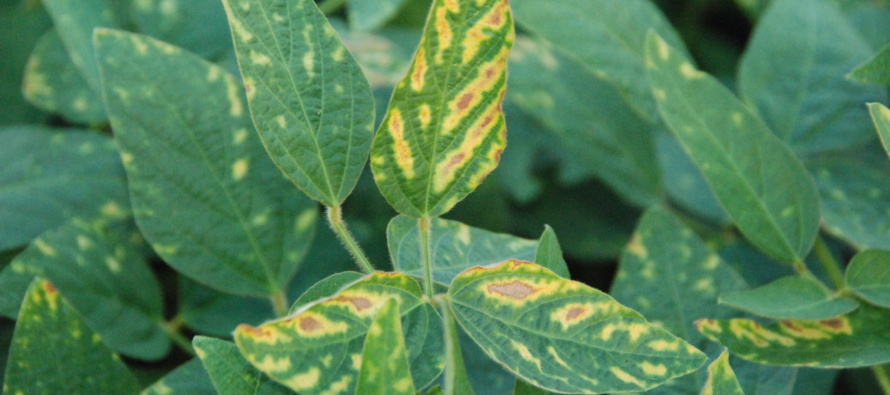Fungicide-Associated Phytotoxicity: Update Following 2015 Observations

Related Articles
- 2010 Soybean And Corn Variety Trial Data 3
- Rice Variety Trial Results For 2010, Plus Rice Research Report 0
- 2010 Row Crop Short Course Video Links 0
Latest Tweets
Over the past several years, phytotoxicity has continued to be an important topic of conversation. Phytotoxicity can ultimately result following the application of numerous fungicide products. The specific symptoms associated with phytotoxicity can appear as interveinal chlorosis (either mild, moderate or severe in some cases) that looks quite similar to several root-associated diseases (e.g., SDS, stem canker, southern blight, root-knot nematode). In addition to the aesthetic injury, phytotoxicity can result in mild defoliation, but this greatly depends on the product applied. In general, any product that contains a triazole (or demethylation inhibitor, DMI) can produce phytotoxicity. Historically, the phytotoxicity observed following fungicide applications was referred to as “tebuconazole phytotoxicity”. Once upon a time, Folicur was the main product that contained tebuconazole. However, over the past several years, additional products have been brought to market that contain tebuconazole. At present, 21 fungicides are commercially available that contain either tebuconazole as a stand-alone active ingredient or with other active ingredients for application in soybean production systems (tebuconazole fungicide product table).
Specific fungicides that produce phytotoxicity
Over the past several years numerous fungicide products have been evaluated in small plot trials in Stoneville. The response of soybean plants to the application of specific fungicide products has differed across multiple seasons. However, the attached table includes all of the products observed to produce phytotoxicity in the Stoneville trials (phytotoxicity response). Fungicide products are rated as either producing a mild, moderate or observationally what I consider to be a severe response. Put more simply, a mild rating would be on the order of a 1-2 on a scale of 0-9 (0=no phytotoxicity and 9=extreme phytotoxicity). The phytotoxicity symptoms associated with fungicides that produce a mild response are in most cases difficult to detect. For example, propiconazole (Tilt) produces just enough phytotoxicity to note that the response occurred. In a 30 foot plot that might be a single leaf which on my rating scale results in a 1, which in most cases simply means “present”.
Variety and phytotoxicity
Be mindful that some varieties respond differently to fungicides that can produce phytotoxicity. Unfortunately, no data exist on the specific response of all varieties to all products that can produce phytotoxicity. During 2015, one OVT location was rated for phytotoxicity following an accidental application of Quadris Top. Only the Maturity Group (MG) IV varieties were able to be rated. The response of specific varieties to additional products that produce phytotoxicity may ultimately differ. Information regarding the response of specific varieties to Quadris Top can be found:
Maturity Group IV Early: https://www.mississippi-crops.com/wp-content/uploads/2015/11/2015-MG-IV-early-Phytotoxicity.pdf
Maturity Group IV Late: https://www.mississippi-crops.com/wp-content/uploads/2015/11/2015-MG-IV-late-Phytotoxicity.pdf
Tank mixing fungicides with adjuvants and herbicides
Unfortunately I do not have near enough data to constructively make the next statement, but take caution in tank mixing products that may produce phytotoxicity with some herbicides especially at reproductive growth stages and pay careful attention to label restrictions. Ongoing research in Stoneville is considering the role of adjuvants in producing (or reducing) phytotoxicity as well as tank mixing specific phytotoxicity producing fungicides with herbicides.
During 2015, several adjuvants (non-ionic surfactant, crop oil concentrate, methylated seed oil, Penetrator Plus, and Dyne-Amic) were mixed with a 3 fl oz/A application of prothioconazole (Proline) and applied at R3. Plots were rated several times to determine the severity of frogeye leaf spot on a frogeye-susceptible soybean as well as the resulting phytotoxicity. Additional trials have been sprayed for the 2016 and are planned for multiple locations to determine the role of specific adjuvants and the resulting phytotoxicity. In addition, trials are planned to determine the role of specific herbicides mixed with products that produce phytotoxicity.
Stressed situations and phytotoxicity
During 2015, some soybean field situations under drought stressed conditions were observed to contain more phytotoxicity following applications of specific fungicides. Be mindful that fields under extreme stress may exhibit additional phytotoxicity following an application of a fungicide that produces phytotoxicity.





Let me tell You a sad story ! There are no comments yet, but You can be first one to comment this article.
Write a comment